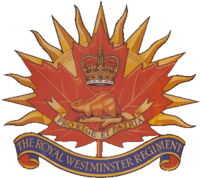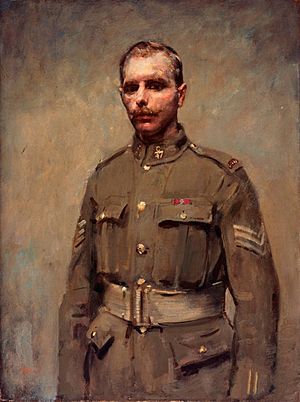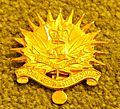Royal Westminster Regiment facts for kids
Quick facts for kids The Royal Westminster Regiment |
|
|---|---|
 |
|
| Active | 1910–present |
| Country | Canada |
| Branch | Canadian Army |
| Type | Infantry |
| Part of | 39 Canadian Brigade Group |
| Garrison/HQ |
|
| Nickname(s) | "The Westies" |
| Motto(s) | Pro rege et patria (Latin: "For king and country") |
| March | "The Maple Leaf Forever" |
| Anniversaries |
|
| Engagements | First World War Second World War War in Afghanistan |
| Battle honours |
Battle honours
Mount Sorrel
Somme, 1916 Ancre Heights Ancre, 1916 Arras, 1917, '18 Vimy, 1917 Hill 70 Ypres, 1917 Passchendaele Amiens Scarpe, 1918 Drocourt–Quéant Hindenburg Line Canal du Nord Valenciennes France and Flanders, 1916–18 Liri Valley Melfa Crossing Gothic Line Coriano Lamone Crossing Misano Ridge Casale Naviglio Canal Italy, 1944–1945 IJsselmeer Delfzijl Pocket North-West Europe, 1945 Afghanistan |
| Commanders | |
| Commanding officer | LCol Clint Uttley |
| Regimental Sergeant Major | CWO Dean Baron, CD |
| Abbreviation | R Westmr R |
The Royal Westminster Regiment, often called the Westies, is a special part of the Canadian Army. It's a Primary Reserve infantry regiment, which means its members are part-time soldiers who train regularly and can be called upon for duty. The regiment is based in New Westminster, British Columbia, and also has a company in Chilliwack, British Columbia. Their motto, Pro rege et patria, is Latin for "For king and country," showing their dedication.
Contents
- A Look at Their History
- Fighting in the Great War
- The Second World War
- After the Second World War
- Serving in Afghanistan
- Alliances with Other Regiments
- Regimental Badges
- Cadet Units
- The Royal Westminster Regiment Museum
- See Also
A Look at Their History
How the Regiment Started
The Royal Westminster Regiment began on April 1, 1910, in New Westminster, British Columbia. It was first known as the 104th Regiment. Over the years, its name changed several times as it grew and combined with other units. In 1966, it officially became "The Royal Westminster Regiment."
Honoring Past Heroes
The regiment "perpetuates" the history of older units. This means they keep alive the memory and achievements of these units, making sure their bravery is never forgotten. The Royal Westminster Regiment honors two units from the First World War:
- 47th Battalion (British Columbia), CEF
- 131st Battalion (Westminster), CEF
Fighting in the Great War

When the First World War began in 1914, the 104th Regiment helped protect local areas. They also formed the 47th Battalion, which traveled to Britain in 1915 and then to France in 1916. This battalion fought bravely in many battles in France and Belgium until the war ended.
One amazing soldier from the 47th Battalion, Corporal Filip Konowal, received the Victoria Cross. This is the highest award for bravery in the British military. He earned it for bravely destroying a German machine gun position all by himself.
Another unit, the 131st Battalion, also went to Britain in 1916. Its soldiers joined other Canadian forces to help as reinforcements on the battlefield.
Between the Big Wars
After the First World War, in 1920, the unit joined with another regiment. In 1924, it was reformed and named The Westminster Regiment. Later, in 1936, it became a machine gun battalion, known as The Westminster Regiment (M.G.).
The Second World War
Mobilizing for War
When Germany invaded Poland in 1939, starting the Second World War, the regiment quickly got ready for action. Its 1st Battalion became a machine gun battalion.
During the war, the regiment was part of the 5th Canadian Armoured Division. They fought in the tough Italian Campaign. Later, they moved to Europe and helped free Holland from enemy control. A second battalion, the 2nd Battalion, stayed in Canada as a reserve force.
Becoming a Motor Battalion
In 1941, the unit changed again, becoming a "motor battalion." This meant they used vehicles to move quickly. They were renamed The Westminster Regiment (Motor). They trained in Canada and then sailed to Great Britain in November 1941.
Training in Great Britain
In Britain, the Westminsters continued their training. They moved to different camps, preparing for the battles ahead. In March 1943, Lieutenant Colonel Gordon Corbould, a former officer with the Westies, took command of the battalion. He would lead them through many difficult fights.
Fighting in Italy
In November 1943, the regiment sailed to Italy. They joined the 8th Army and soon faced combat near the town of Guardiagrele. They developed clever tactics, like sending patrols behind enemy lines at night to call in artillery fire.
The Battle of the Melfa River
One of the regiment's most famous actions was the crossing of the Melfa River in May 1944. Major Jack Mahony, who led "A" Company, showed incredible bravery and leadership. He was awarded the Victoria Cross for his actions during this battle. This event also created a strong bond between the Westminsters and the Lord Strathcona's Horse (Royal Canadians) tank regiment.
Pushing Through the Gothic Line
After the Melfa River, the Westies continued their advance. They faced the strong German defensive position known as the Gothic Line in August 1944. They fought hard, crossing rivers and pushing the enemy back.
Battles on the Adriatic Coast
In the winter of 1944, the regiment was involved in intense battles along the Adriatic coast. They crossed rivers like the Montone and Lamone, capturing towns and facing strong German resistance. They fought continuously for over 40 days and nights, showing incredible endurance.
Moving to Northwest Europe
In February 1945, the Westminsters left Italy and traveled to Belgium. They then moved into the Netherlands, where they continued to fight.
The Drive to the Zuider Zee
In April 1945, the regiment was part of a major offensive. They crossed the IJssel River and pushed through Arnhem, driving towards the Zuider Zee. They captured airfields and towns, taking many prisoners and cutting off thousands of German troops.
The Final Battle
The regiment's last action was capturing a German anti-aircraft battery at Termunterzijl. This was a tough fight against strong defenses, but the Westminsters' determination forced the enemy to retreat.
End of the Second World War
The war in Europe ended on May 7, 1945. The soldiers returned home, traveling across the ocean and then by train to Vancouver. They marched proudly through New Westminster, and on January 19, 1946, they were officially dismissed.
A Record of Success
During the Second World War, over 4,000 men served in The Westminster Regiment (Motor). Sadly, 134 of them lost their lives. The regiment earned many awards for bravery, including one Victoria Cross. They were known for always achieving their objectives, a truly outstanding record!
After the Second World War
Changes and New Roles
In 1954, the regiment dropped the "Motor" from its name. Then, in 1966, it gained the "Royal" title, becoming The Royal Westminster Regiment.
In 1948, the regiment helped during the Fraser River Floods, providing aid to the community for three weeks.
Over the years, the role of reserve units like the Westies changed. They focused more on training and supporting international missions.
Freedom of the City
The City of New Westminster honored The Westminster Regiment in 1963 by granting them "freedom of the city." This is a special tradition that allows military units to march through the city with drums beating and flags flying. Pitt Meadows, British Columbia also granted them this honor in 2012.
Serving the United Nations
The Royal Westminster Regiment has sent its soldiers to many United Nations missions around the world. They have served in places like Cyprus, Egypt, the Golan Heights, and the former Yugoslavia, helping to keep peace and provide support.
Serving in Afghanistan
Between 2002 and 2014, the regiment sent many of its members to serve in Afghanistan. More than 20% of their soldiers contributed to the various task forces there, showing their continued commitment to Canada's military efforts.
Alliances with Other Regiments
The Royal Westminster Regiment has a special friendship, or "alliance," with another military unit:
 United Kingdom – The Royal Regiment of Fusiliers in Great Britain.
United Kingdom – The Royal Regiment of Fusiliers in Great Britain.
Regimental Badges
-
The hat badge worn by The Westminster Regiment during World War II.
Cadet Units
The Royal Westminster Regiment supports several Royal Canadian Army Cadets units in British Columbia. These cadet units include:
- 1789 RCACC in Hope
- 1922 RCACC in CFS Aldergrove
- 2316 RCACC in New Westminster
- 2822 RCACC in Surrey
- 1838 RCACC in Maple Ridge
Cadets in these units receive support from the regiment and can wear some of the regiment's traditional uniform items.
The Royal Westminster Regiment Museum
| Location | The Armoury, 530 Queens Avenue, New Westminster, British Columbia, Canada |
|---|---|
| Type | Regimental Museum |
The museum collects and displays military items and memories from the regiment's past. It helps people understand the important contributions the regiment has made to the community and Canada. The museum aims to inspire pride in those who serve.
See Also







